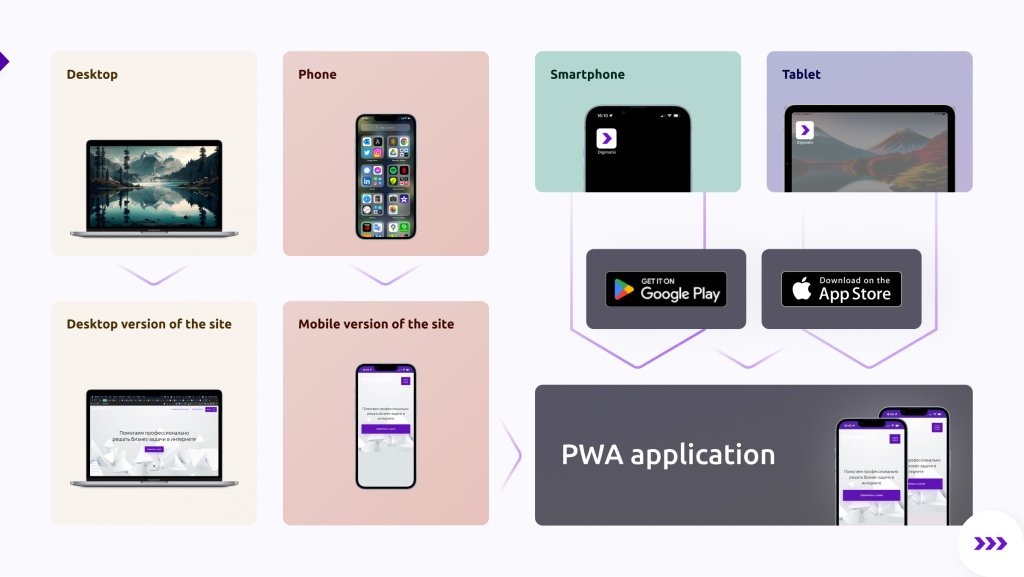
How to create a loyalty program based on a PWA application
Loyalty programs are an effective tool for companies aiming to build long-term relationships with customers, increase satisfaction, and, of course, boost revenue. However, to create a successful loyalty program, many aspects need to be considered to ensure it doesn’t become a source of problems or losses. In this article, we—the team at DOTSENKO.PRO—will discuss how to create a loyalty program that works.
What types of loyalty programs are there?
Bonus points
This is one of the most popular types of loyalty programs. It involves awarding points to customers for purchasing products or services. These points usually have a monetary equivalent. Customers can use the accumulated points for partial or full payment for future purchases.
Personal and accumulative discounts
This type of loyalty program is also widespread. The company provides customers with a discount on purchases, which can be either accumulative or fixed.
Individual promo codes
Recently, loyalty programs based on the individual needs of customers have gained popularity. Companies use artificial intelligence to analyze customer behavior and offer personalized promotions.
Referral system
This type of loyalty program is designed to stimulate word-of-mouth recommendations. The company offers customers a reward for referring products or services to friends.
Combined loyalty programs
These programs combine multiple types of loyalty programs. For instance, earning bonus points and using a referral discount system simultaneously.
Trends in Loyalty Programs for 2024
Gamification
Gamification in loyalty programs has gained significant popularity recently. Companies engage customers through challenges that come with rewards. These prizes usually have no material value but create a sense of connection with the company.
Eco-friendliness trend
Large companies increasingly focus on environmental issues, and this trend has become more noticeable and relevant for customers. Let's consider two successful eco-friendly loyalty programs:
-
H&M offered customers a 15% discount in exchange for bringing in clothing items they no longer used for recycling.
-
LUSH provided customers with the opportunity to exchange empty plastic containers from their purchased cosmetic products for a free new product.
Partnerships
Partnership programs are another effective way to attract and retain customers. The main idea is that customers can accumulate bonus points, discounts, or other perks by making purchases not just from one company but also from its partners. This encourages customers to choose these brands and products more often. Partnership programs are successful when they offer real value to customers and are easy to use and understand.
Companies involved in partnership programs gain access to new customers and expand their audience. This also helps reduce marketing costs. These examples illustrate how companies are actively incorporating eco-friendly loyalty programs, responding to the growing interest in sustainable consumption.
Emotional engagement
Companies increasingly use emotional engagement to build a loyal customer base. Interactive approaches and non-material motivation make customers feel connected to the brand and align themselves with the company's values.
One great example of emotional engagement is the IKEA Family card. It allows customers to exchange and return purchases without a receipt, attend free home improvement events, and much more.
What to consider when implementing a loyalty program
Defining the goals of the loyalty program
The goals depend on what the company wants to achieve: increasing repeat purchases, attracting new customers, raising the average purchase value, building customer loyalty, collecting data, and conducting analytics.
Analyzing the target audience
Studying the target audience helps identify customer needs, preferences, and motivations. This allows for the creation of a loyalty program that is relevant and appealing to the company's customers.
Establishing clear rules and conditions
Clearly defining the rules and conditions of the loyalty program is essential. This includes information on how customers can participate, how rewards are earned or issued, and how they can be used.
Communication and marketing
Develop a communication and marketing strategy to draw attention to the loyalty program. Use various channels such as email, social media, advertising, and direct customer interactions.
Analysis and optimization
Monitor the results of the loyalty program, analyze data, and collect feedback from customers. Use this information to optimize and improve the program over time.
PWA application for creating a loyalty program
For certain business sectors, having a mobile app with an active loyalty program is crucial as customers make frequent purchases. In this case, PWA technology can be a valuable solution.
PWA (Progressive Web Application) technology allows a website to be installed on a smartphone, turning it into an app. The main advantages of this technology include low development costs, short implementation timelines, push notification support, and the ability to work offline without a constant internet connection. Additionally, it is not necessary to publish the app in the Apple Store or Google Play to use it.
A PWA app can bring all the website's functionality into a standalone mobile app. For instance, if the website already has a user account with a connected loyalty program, it can quickly be turned into an app. And if the user account and loyalty program do not yet exist, expanding functionality and integrating them into the website framework can be faster and more cost-effective.
How does it work?

The user only needs to install the app, log in once, and then they can use the site’s account and loyalty program without any restrictions.
In this way, within a single website, a mobile app can be quickly and inexpensively created, enhancing customer satisfaction and driving additional sales (assuming such functionality is available in the user account).


